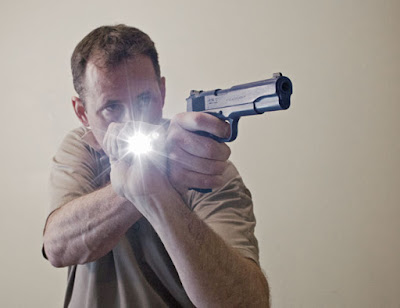We used the San Antonio Police Department target and scored it as five points in the inner “bottle,” four points inside the next scoring area, and zero points outside the four point ring or for misses.
We shot a single speed qualifier in daylight for a control score and then in low light with no moon. I shot the qualifier as well and achieved a 300 with a 5-5/8ths inch group. I used a P320 Carry with Lima Module, a Trijicon Red Dot and a Fenix hand-held flashlight.
To learn more about the MAG20 qualifier, go to the link here.
 |
| SIG P320 Carry with the LIMA Module |
Given these challenges, I allowed the students to use the Isosceles or if they preferred the modified Chapman or Weaver. At 15 yards, I shot it using the Weaver, then Chapman, then Weaver and used the
Harries flashlight technique.
 |
| Harries Technique |
You can practice these techniques with live fire during daylight if your range won’t allow night shooting. If your local range has IDPA matches, shoot the course of fire using your flashlight if the match director will permit it. You won’t win the match; however, you will learn how to shoot and manipulate your pistol under some stress.
To my knowledge, no data exists concerning private citizen-involved shootings with criminals under low light conditions; however, since a lot of criminal activity occurs after dark we can assume that there is a likely correlation. There are several reasons to use a flashlight: to observe and detect, to illuminate and navigate, to eliminate anonymity, and to identify and engage threats. Used properly, a flashlight lets you see danger before it can affect you and it can encourage the danger waiting in the dark to go elsewhere.
If you enjoy reading these please subscribe. The link is on the upper right side of the page. All that will happen is that you will receive an e-mail when I post an article. Your information will never be distributed.

No comments:
Post a Comment